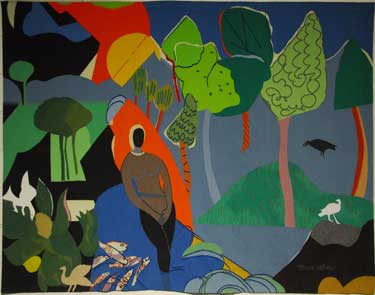Romare Bearden
Recollection Pond (1975) - Aubusson Weave Wool Tapestry, 5.1' x 6.7'

Recollection Pond (1975), by Romare Bearden and Gloria Ross Tapestries, Inc.) - Click Image for High-Resolution
Romare Bearden was born in Charlotte, North Carolina. His family moved to Harlem, New York when he was very young. Bearden graduated from New York University in 1935 with a BS in Mathematics. Although he later studied art history and philosophy in Paris, Bearden never received a degree in Fine Art. He was active in Harlem’s art world as a member of the Harlem Artists Guild, and a founding member of the Spiral Group, a collective of African-American artists.
Bearden studied life drawing and painting at the Art Students League with German painter and political cartoonist George Grosz. Coupled with his background in mathematics, Bearden’s interest in the socio-political condition of African Americans made bold statements of his now famous collages. Made out of paper fragments, the faces, places and objects in his pictures are constructed with studied precision and insight into human nature.
Bearden had family ties that took him to St. Martin where the island’s atmosphere influenced many of his works. Recollection Pond, a hand-woven tapestry based on his 1970 photo collage Memories, is a richly colored wool weaving dominated by a bright tropical landscape. It boasts a variety of foliage and exotic birds bathed in sunshine.2 The female nude in the foreground is a natural part of the environment as she wades with fish as her companions in a shallow pool.
Bearden was elected to the American Academy of Arts and Letters and was a recipient of the President’s National Medal of Arts. His work appears in numerous private and public collections such as the Metropolitan Museum of Art, The Whitney Museum of American Art, and The Studio Museum in Harlem.
Recollection Pond was created in collaboration with Gloria Ross Tapestries, Inc., and was one of dozens of Ross' collaborations with artists. York College’s tapestry is the fourth of an edition of seven (plus one artist's proof) woven by Gloria F. Ross. Mount Holyoke College Art Museum (#2) and the Metropolitan Museum of Art (#7) are among the owners the tapestries.2 The Recollection Pond tapestry on display at the World Trade Center (#3) was destroyed on September 11, 2001.3
Links to Related Content (links open in a new window)
- The National Gallery of Art - The National Gallery's treatment of Romare Bearden is extensive and includes a biography, discussion of his interests, styles and techniques, and more than thirty images of his work. (http://www.nga.gov/feature/bearden/index.shtm)
- The Gloria Ross Center for Tapestry Studies - Gloria F. Ross collaborated with dozens of artists, working to turn artists' paintings into tapestries. The Gloria Ross Center for Tapestry Studies captures much of this work, and more. (http://tapestrycenter.org/index.htm)
- Romare Bearden at the Met - In 2004-05, the Metropolitan Museum of Art held an exhibition of Bearden's work that featured his collage of Harlem street life and Recollection Pond, together with some early studies. The exhibition poster featured a detail from Recollection Pond, and the exhibition website offered an interactive, Flash-based "feature designed for kids, parents, and teachers." (http://www.metmuseum.org/explore/the_block/index_flash.html)
Notes
- Biographical data on Bearden can be found in Myron Schwartzman, Romare Bearden: His Life and Art (New York, 1990), or visit http://www.beardenfoundation.org.
- Information about the owners and editions of Recollection Pond is available at The Gloria F. Ross Center for Tapestry Studies gallery. (http://tapestrycenter.org/)
- Information about the loss of the edition of Recollection Pond owned by the Port Authority of New York and New Jersey provided by Wenegrat (2002). Wenegrat, S. (2002, February 28). Public art at the World Trade Center. In S. Flescher (Ed.) September 11: Art Loss, Damage, and Repercussions. New York: International Foundation for Art Research. Retrieved September 29, 2008, from http://www.ifar.org/911_public1.htm.

